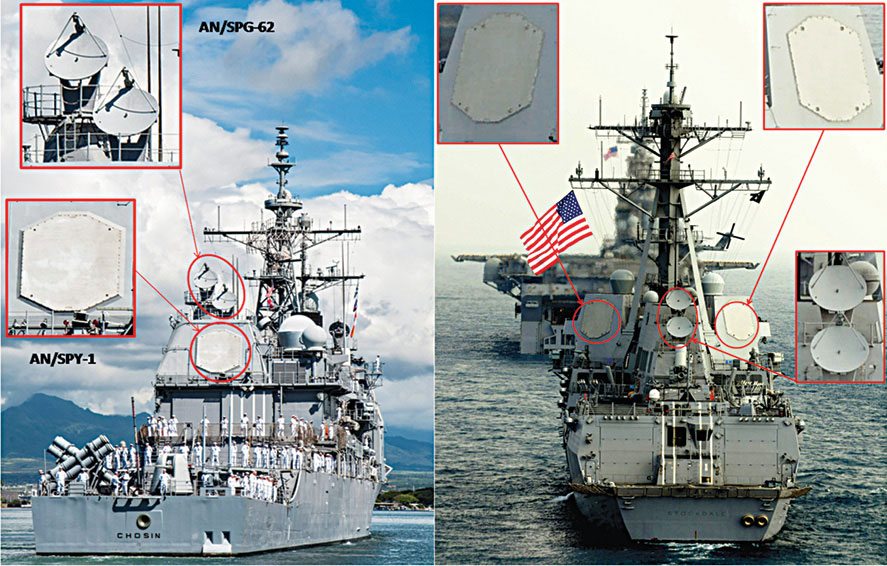As reception does not involve huge power requirements, the receiver fits snugly into the requirement. The ship, which launches the missile, provides radar energy through an illumination-/fire-control radar. This radar does not chirp out pulses but continuously focuses its high-energy radar signals on the incoming target. Reflected energy is picked up by the missile seeker.
The missile’s guidance system understands the position of the target due to the directional property of this received radar energy. Then, the guidance system aligns the missile for successful interception and intercepts the target to destroy it.

In Aegis cruisers and destroyers, SM-2 missiles are stored in a vertical launching system (VLS), which can hold 122 missiles in total and those present in destroyers can hold 96 missiles.
VLS is a generalised launcher system and can launch many types of missiles. Though depending on mission requirement, various types of missiles could be loaded to this VLS. For complex missions, entire VLS could be loaded with SM-2 missiles.
AN/SPG-62 illumination-/fire-control radars. This radar operates in I/J NATO frequency band (8GHz-20GHz) with a peak power of approximately 10kW. It is a continuous-wave illumination radar and does not chirp out signals as pulses. Instead, it focuses its energy as a fine pencil beam on the target, like focusing a flashlight on an object. Due to this, this radar is called an illumination radar.
In military parlance, this is known as painting the target. This radar is mechanically turned to steer the beam. There are four such radars in Aegis cruiser; two are rearward-facing and two are forward-facing. This arrangement provides 360° coverage. With each radar illuminating a target, these radars can illuminate up to four targets.
Aegis destroyers have three of these radars and the absence of AN/SPN-49 radar leaves it with lower air defence capability. This makes Aegis cruisers a prime node in the air defence architecture of CSG defending against cruise missile strikes.
Typical engagement sequence
In the engagement sequence, first, incoming target is detected through AN/SPN-49 surveillance radar. Aegis C2 system directs that target to be tracked by AN/SPY-1 radar. From this tracking, the target’s trajectory is derived in Aegis C2 system and the target’s future course is computed. Then, the point of interception is calculated, which is a place where the target can reach in a few moments. SM-2 SAM is launched to reach this interception point through midcourse guidance.
Due to the very long range involved, the parent vessel gives commands for the missile to fly, which is called midcourse guidance. These commands are supplied through a datalink, typically a radio channel. The missile receives this information through the datalink and flies accordingly. AN/SPY-1 radar provides this datalink too.
By the time SM-2 approaches incoming target, Aegis C2 system directs the fire-control radar to illuminate the incoming target. When the missile reaches an optimum distance from the target, it starts using its radar receiver and guides itself towards the target.
AN/SPY-1 allows many such beams to be formed. Because of this, many datalink channels can be established so that many SM-2 missiles can be given guidance commands. This enables many missiles to stay on air to intercept the same target or multiple targets.
Similarly, Aegis C2 system time shares illumination radars for a large number of targets to neutralise simultaneous cruise-missile strikes. The number of targets that could be engaged through this feature is kept as classified information. But without this time-sharing feature, the number of targets intercepted will be equal to the number of fire-control radars.
Cooperative engagement capability, the latest trend
As the CSG’s cruise missile defences increased in capability, the Soviets fielded faster cruise missiles; some of these cruise missiles were even capable of covering a kilometre in a second. Because of this high speed, reaction time for the CSG decreased to a great extent. Windows of interceptions also reduced for the CSG against these faster cruise missiles.
The Soviets also increased the range of cruise missiles. They augmented the number of cruise missiles carried by cruise-missile-carrying platforms. Soviet submarines, surface vessels and bombers were able to carry more cruise missiles in a compact manner. So, more number of cruise missiles of lethal speed could be fired from longer range and also in greater numbers.
Though Soviet Union is defunct now, Russian Federation and China have this cruise missile strike capability. To defend from this renewed attack of fury, American CSGs needed a new deal in cruise missile defence.










